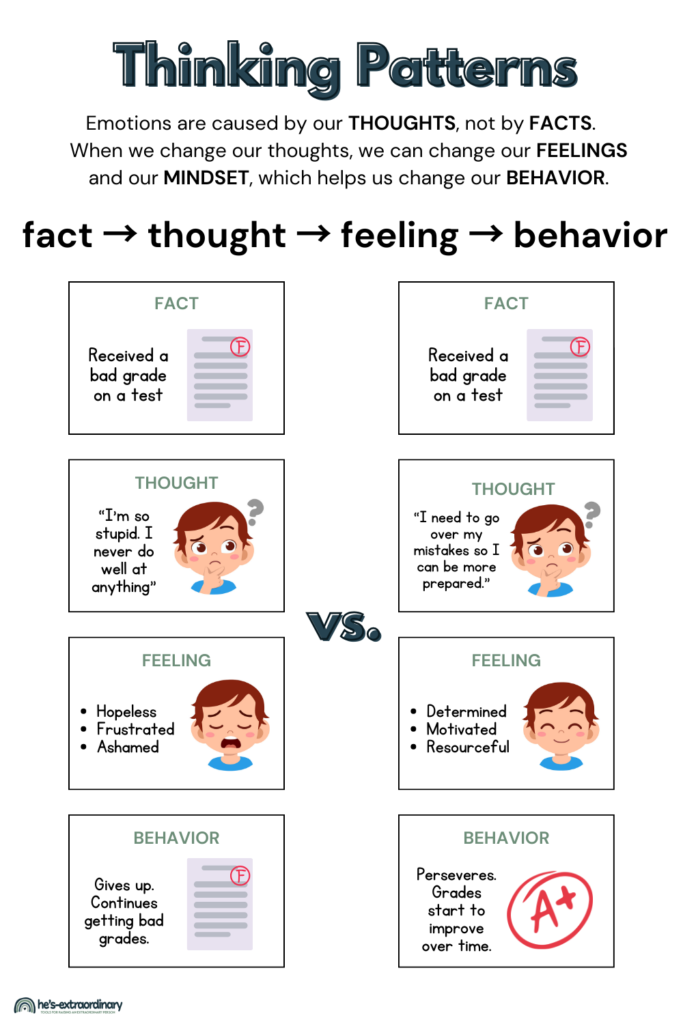9 Mindfulness Activities for Kids With ADHD
What’s inside this article: A review of what mindfulness is, along with the benefits of mindfulness for kids with ADHD. Then, a list of 9 easy mindfulness activities to try with your kids.
Disclaimer: This post contains affiliate links.
What is Mindfulness?
Mindfulness is a mental practice that involves focusing your attention on the present moment. We often spend a significant amount of our time thinking about things that happened in the past or worrying about things that might happen in the future. But, when practicing mindfulness, you’re fully aware of where you are and what you’re doing without being overly reactive or overwhelmed by what’s going on around you.
Mindfulness encourages you to pay close attention to your thoughts, feelings, and sensations as they occur. This heightened awareness can help you notice how your mind and body respond to different situations.
This technique, which has proven beneficial in dealing with anxiety, can be an effective tool for managing ADHD, too.
Harnessing Mindfulness for ADHD
From my personal experience, recalling and applying these techniques in real-time when you’re feeling stressed or overwhelmed is difficult. However, with consistent practice, it is doable and beneficial.
Using mindfulness for ADHD may help your child improve attention and self-regulation.
However, the skills learned from mindfulness are helpful to everyone. When being mindful, you are aware of your bodily sensations, feelings, thoughts, and what is happening around you.
Benefits of Mindfulness For Kids With ADHD
Mindfulness has numerous benefits for children with ADHD, including:
- Enhances Working Memory: Helps address common working memory-related challenges in ADHD kids, aiding in tasks such as following instructions and recalling tasks.
- Boosts Focus and Concentration: Grounding exercises can make it easier to focus and pay attention because you’re in the present moment.
- Emotional Self-Regulation: Mindfulness helps kids understand their emotions and respond to emotions in a controlled manner, reducing the likelihood of meltdowns.
- Improves Attention Span: Mindfulness practices can train the brain to be present, leading to an overall increase in attention span.
- Stress Reduction: Mindfulness techniques, such as deep breathing, can provide immediate relief from anxiety and stress, which are common for kids with ADHD. Other techniques, like meditation, can improve stress long term.
- Improves Self-awareness: Helps children understand their thoughts, emotions, and reactions better, promoting self-control and self-awareness
- Impulse Control: Regular mindfulness exercises can teach children to pause and think before acting, countering impulsive behavior.
- Better Sleep Patterns: Mindful relaxation can lead to improved sleep, which is beneficial as ADHD kids often struggle with sleep issues.
- Builds Executive Functions: Regular mindfulness practice can improve the brain’s executive functions, which include attentional control, cognitive inhibition, and task switching.
- Helps Build Resilience: Equips children with tools to handle challenging situations, making them more resilient to setbacks.
- Improves Academic Performance: The cumulative effects of better focus, memory, and emotional regulation can lead to better academic achievements.
Mindfulness Activities for Children

Thinking about introducing mindfulness practices to your child?
Start by involving the whole family in mindful exercises – they’re beneficial for everyone. Avoid pressuring your child. If they choose to watch from the sidelines, that’s okay.
Their curiosity might lead them to join in later. It should be an enjoyable stress free practice, so forcing compliance would be counterproductive.
Below are some activities to spark their interest:
1. Mindful Eating Exercise
Doing a mindful eating activity is a great place to start with children when teaching mindfulness.
It’s a much better way to engage your child and help them to understand what mindfulness is than the traditional guided meditation or breathing (that comes later but it’s a struggle for children who have difficulty focusing).
- Give your child a piece of food and instruct them not to eat it yet. (This could be something like a piece of chocolate or a berry) You can bring out multiple foods at once to allow them to think about the differences between each one.
- Tell them to imagine they have never tried this food before and to hold it in their hand and think about how it feels (the temperature, texture, etc.)
- Then, ask them to bring it up to their nose and think about how it smells.
- Ask them if smelling the food evokes any emotions (hint – the urge to eat it – you may need to point that out to them).
- Finally, tell them to eat the food –really slowly. Ask them how it feels as they chew – any changes in texture, flavor, etc.
This is the perfect way to introduce mindfulness to your children because it brings them into the present moment in an enjoyable way.
2. Out-loud Sense Noting
This is an activity where you take turns noticing what is happening around you, and then you give the other a sense to notice (Taste, touch, hear, smell, seeing, thinking).
- Start by saying, “Right now, I am noticing…”
- State something you notice in the given category. For example, “Right now, I am noticing the sound of the cars driving by outside.”
- Then, give them the sense to notice for their turn, for example, touch. They could then say “Right now, I am noticing the way the leather sofa feels on my legs”.
This activity encourages active listening and can also help your child, and even you, to pay attention to things you may not notice normally.
3. Color!
Coloring is a great way to encourage your children to relax and be in the present. It is a means of self-regulation, too. Encourage them to color in silence.
Be Happy & Color is a beautiful children’s mindful coloring book available on Amazon. The coloring book was created by Hannah Klaus Hunter, an art therapist at a children’s hospital.
The book helps children learn to express themselves and support their emotional well-being.
There are guided therapeutic instructions along with the pictures to promote feelings of calm, happiness, and well-being and help children combat feelings of sadness or anxiety.
4. The Mindful Jar
Also known as a sensory jar or a calm-down jar, these are fun DIY activities to do with your kids. You and your child should make the jars together.
We made this winter-themed glitter jar, but you can be creative and add whatever you want.
When the jar is complete, shake it up. Then, get your child to watch the jar until all the glitter settles. It’s mesmerizing.
You can relate this to mindfulness by explaining to your child that our thoughts and feelings are just like glitter – when we are upset, they spin all over the place inside our heads. We need them all to settle before we can calm down.
Plus, the act of watching the glitter is calming in itself, and it’s also a great visually stimulating activity.

5. Deep Breathing
Deep breathing is a key part of being mindful, and it is necessary to learn if you want to manage ADHD through mindfulness.
Our bodies and our minds are connected. That’s why there’s a physiological response to emotions. Deep breathing helps calm down the body by controlling the physiological reactions, which, in turn, helps calm our minds as well.
You can find 7 deep breathing activities for kids here (with printables).
6. Body Scan
The following steps for doing a body scan with your child were found on www.mindful.org and were written by Mark Bertin, author of “Mindful Parenting for ADHD.”
Listen and save to the guided body scan, or click the link to read the step-by-step process.
Dr. Mark Bertin is a developmental & behavioral pediatrician. His book about mindful parenting is available on Amazon.
I have personally used guided body scans for myself to feel more calm and focused. If you haven’t tried it yourself, as a parent, look on YouTube and try some short guided meditations.
I also attended a webinar about how to manage ADHD with mindfulness. The woman speaking on the webinar recommended this book of mindful activities for kids. The book is amazing (check out the ‘look inside‘ on Amazon), it has 55 activities, and they are all explained step by step and easy to follow.
7. Observing Your Mind
We are not our thoughts or feelings.
If your child can understand that and view their thoughts and feelings as something separate from themselves, they can learn not to allow their thoughts to have control over their behavior. And the truth is our negative thoughts are usually blown out of proportion.
The pattern is thought → feelings → behavior
Example:
“I’m too stupid to do this math work” → sadness and frustration → skips school

When children learn that they are separate from their thoughts, they will also understand that they have control over how they react to these thoughts.
I know it sounds really complex, but don’t underestimate your child. They are more self-aware than you may realize. Read more about overcoming negative thinking patterns here.
Thoughts are like trains.
Teach your child that their thoughts are like trains passing through a station. Your child has the ability to stand at the station and watch the trains go by.
Sometimes a train passes straight by, and sometimes it stops to stay for a while. This may make them feel upset, scared, anxious, etc. But these trains will leave the station too. Have your child “watch” as the train leaves.
Explain that in time, just like the train, our thoughts move on and we stay behind.
This simple exercise can teach our kids we don’t have to react to every thought. We can simply observe them. In doing this, the goal is not to change our thoughts but rather to change our relationship with them.
8. Guided Meditations
Guided meditations pull multiple mindfulness practices (like deep breathing, visualization, grounding) into one and have many benefits for kids with ADHD. For kids with ADHD, guided meditations can help:
- Increase focus and prolong attention span
- Reduce stress and anxiety
- Build resilience and a growth mindset
- Improve emotional regulation
- Enhance self-awareness and empathy
I’ve created some fun guided meditations for kids, which you can view here. Look for themes that are likely to be of interest to your child, as they’ll be more likely to engage in the entire meditation this way.
9. STEM Projects
STEM projects require attention to detail. Whether it’s coding a new game or observing a plant’s growth, the child needs to be present in the moment. This inherent demand for focus has parallels with mindfulness.
Practicing being present for STEM projects can help make it easier for them to practice mindfulness for self-regulation – like using visualization or grounding techniques when they’re upset.
An easy way to embark on STEM projects with your kids is through STEM Kits from MEL Science. They provide some of the most intriguing and well-thought-out STEM kits available. These kits are tailored to spark curiosity while also being ripe with opportunities for social-emotional learning.
There is no one-size-fits-all method of managing ADHD; everyone is unique. Whether taking the natural approach or medicating, mindfulness can be a helpful addition to your plan.
Sources :
www.gozen.com/trains/
www.jugglingwithkids.com
www.mindful.org

